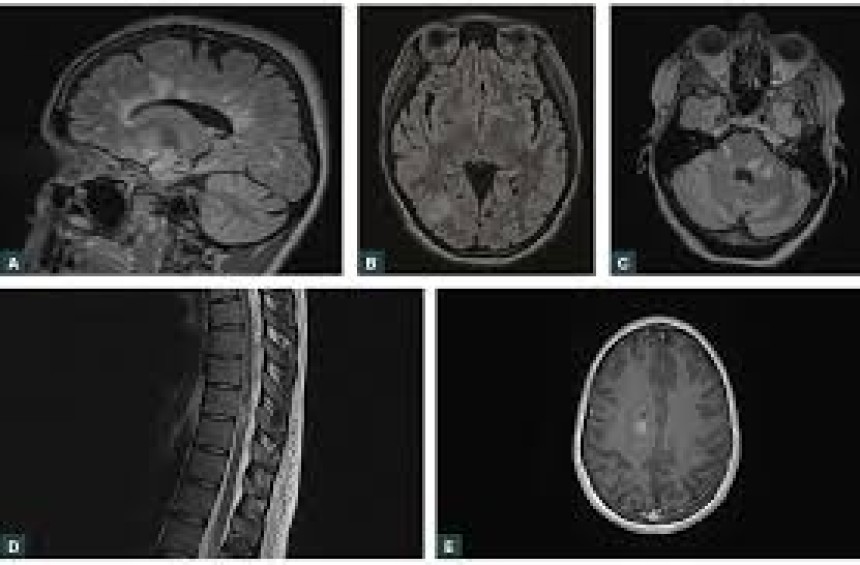
Multiple sclerosis RRMS Choice of Initial Disease modifying Drugs
Disease Modifying Therapies (DMT) for Relapsing Remitting MS (RRMS) include oral agents (dimethyl fumarate, teriflunomide), infusion therapies (natalizumab, ocrelizumab), and injections (interferon beta, glatiramer). Selection depends on disease severity, side effects, and patient preference. Oral agents are easy to use but require safety monitoring, while infusions target active disease but have higher risk profiles. Injections are safer but less potent. Treatment usually continues indefinitely.
Disease Modifying Therapies for RRMS
Oral Agents
Oral agents, such as, dimethyl fumarate (the starting dose is 120 mg twice daily. After 7 days, the dose is increased to 240 mg twice daily), teriflunomide (14 mg daily), monomethyl fumarate (starting at 95 mg twice daily for 7 days and then increased to the maintenance dose of 190 mg twice daily), fingolimod (0.5 mg daily), siponimod ( starting at 0.25 mg daily on days 1 and 2, followed by once daily doses of 0.5 mg on day 3, 0.75 mg on day 4, and 1.25 mg on day 5, to reach the patient's prescribed maintenance dose from day 6), ozanimod (starting at 0.23 mg daily on days 1- 4, then, escalate to 0.46 mg daily on days 5-7, then escalate to 0.92 mg daily from day 8) and cladribine (at a cumulative dosage of 3.5 mg/kg divided into two yearly treatment courses (1.75 mg/kg per treatment course to be given every 6 months. Each treatment course is divided into two treatment cycles of four or five days separated by approximately four weeks). (1, 2, 3, 4, 5, 6)
Infusion Therapy
Infusion therapy, such as, natalizumab (300 mg intravenous (IV) infusion every 4 weeks), ocrelizumab at an initial dose of 300 mg IV infusion, followed by a second 300 mg IV infusion 2 weeks later. Six months later, it is given at 600 mg IV infusion every 6 months and alemtuzumab (12 mg daily for five consecutive days then 12 mg daily for three consecutive days 12 months later). (7, 8, 9)
Injection Therapies
Injection therapies, such as, interferon beta-1a (30 mcg intramuscular injection once a week), interferon beta-1B at 0.25 mg every other day subcutaneously, and glatiramer (Either 20 mg daily or 40 mg three times a week by subcutaneous injection). (10, 11, 12)
Choice of DMTs Based on Individual Needs:
Amongst DMT, the choice of a specific starting agent should be individualised based on current disease activity status, comorbidities, side effects and patient's preference. Oral agents are considered primarily for patients who want to avoid injections and prefer a self administered medication. However, these agents are associated with serious side effects, so clinicians must monitor their toxicities. Dimethyl fumarate is the most widely used DMT with its better safety profile compared to other agents. While, cladribine is reserved to patients who failed other oral lines. Infusion therapy class is particularly for patients with more active disease and those who mostly value efficacy and less worried about safety. These agents are associated with serious side effects including progressive multifocal leukoencephalopathy (PML). Alemtuzumab is usually reserved for patients who have an inadequate response to other agents. While, injection therapy class is for patients who value safety and are less concerned with achieving the highest effectiveness. ((13, 14, 15)
Duration of DMT Therapy
Most DMT are continued indefinitely in clinically stable patients with RRMS unless safety concerns arise. (16, 17)
References
1-Giovannoni G, Hawkes C, Lechner-Scott J, et al. The COVID-19 pandemic and the use of MS disease-modifying therapies. Mult Scler Relat Disord 2020; 39:102073.
2-Harding K, Williams O, Willis M, et al. Clinical Outcomes of Escalation vs Early Intensive Disease-Modifying Therapy in Patients With Multiple Sclerosis. JAMA Neurol 2019; 76:536.
3-Rosenkranz T, Novas M, Terborg C. PML in a patient with lymphocytopenia treated with dimethyl fumarate. N Engl J Med 2015; 372:1476.
4- He D, Zhang C, Zhao X, et al. Teriflunomide for multiple sclerosis. Cochrane Database Syst Rev 2016; 3:CD009882.
5- Bafiertam (monomethyl fumarate) delayed-release capsules, prescribing information.https://www.accessdata.fda.gov/drugsatfda_docs/label/2020/210 296s000lbl.pdf (Accessed on May 06, 2020).
6-Rae-Grant A, Day GS, Marrie RA, et al. Practice guideline recommendations summary: Disease-modifying therapies for adults with multiple sclerosis: Report of the Guideline Development, Dissemination, and Implementation Subcommittee of the American Academy of Neurology. Neurology 2018; 90:777.
7-Rı´o J, Comabella M, Montalban X. Multiple sclerosis: current treatment algorithms. Curr Opin Neurol. 2011;24:230–7
8-Hughes R, Pedotti R, Koendgen H. COVID-19 in persons with multiple sclerosis treated with ocrelizumab - A pharmacovigilance case series. Mult Scler Relat Disord 2020; 42:102192.
9-Carandini T, Pietroboni AM, Sacchi L, et al. Alemtuzumab in multiple sclerosis during the COVID-19 pandemic: A mild uncomplicated infection despite intense immunosuppression. Mult Scler 2020: 1352458520926459.
10-Kasper LH, Reder AT. Immunomodulatory activity of interferon-beta. Ann Clin Transl Neurol 2014; 1:622.
11-Durelli L, Verdun E, Barbero P, et al. Every-other-day interferon beta-1b versus once-weekly interferon beta-1a for multiple sclerosis: results of a 2-year prospective randomised multicentre study (INCOMIN). Lancet 2002; 359:1453.
12-Comi G, Filippi M, Wolinsky JS. European/Canadian multicenter, double-blind, randomized, placebo-controlled study of the effects of glatiramer acetate on magnetic resonance imaging--measured disease activity and burden in patients with relapsing multiple sclerosis. European/CanadianGlatiramer Acetate Study Group. Ann Neurol 2001; 49:290.
13-Cohen JA, Barkhof F, Comi G, Hartung HP, Khatri BO, Montalban X, Pelletier J, Capra R, Gallo P, Izquierdo G, Tiel-Wilck K, de Vera A, Jin J, Stites T, Wu S, Aradhye S, Kappos L, TRANSFORMS Study Group. Oral fingolimod or intramuscular interferon for relapsing multiple sclerosis. N Engl J Med. 2010;362:402–15.
14-Fox RJ, Cutter G, Chan A, et al. Comparative Effectiveness Using A Matching-Adjusted Indirect Comparison Between Delayed-Release Dimethyl Fumarate and Fingolimod for The Treatment of Relapsing-Remitting Multiple Sclerosis. Value Health 2015; 18:A750.
15-Kalincik T, Brown JWL, Robertson N, et al. Treatment effectiveness of alemtuzumab compared with natalizumab, fingolimod, and interferon beta in relapsing-remitting multiple sclerosis: a cohort study. Lancet Neurol 2017; 16:271.
16-Montalban X, Gold R, Thompson AJ, et al. ECTRIMS/EAN Guideline on the pharmacological treatment of people with multiple sclerosis. Mult Scler 2018; 24:96.
17-Rae-Grant A, Day GS, Marrie RA, et al. Practice guideline recommendations summary: Disease-modifying therapies for adults with multiple sclerosis: Report of the Guideline Development, Dissemination, and Implementation Subcommittee of the American Academy of Neurology.Neurology 2018; 90:777.





